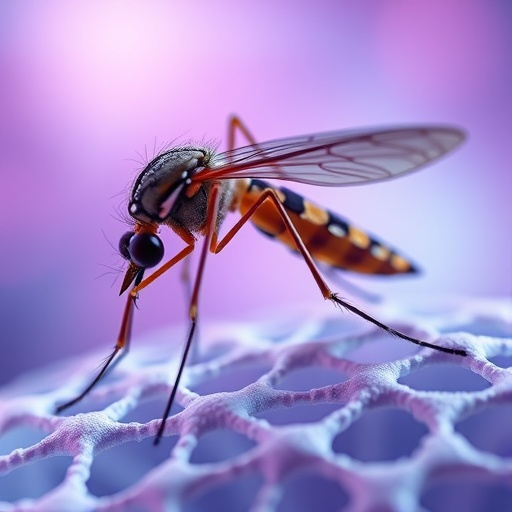Australian scientists at the Walter and Eliza Hall Institute (WEHI) have made a groundbreaking discovery in the fight against malaria by visualizing, for the first time, the intricate structure of a crucial protein complex that enables the malaria parasite to reproduce within mosquitoes. This achievement, enabled by advanced cryo-electron microscopy (cryo-EM) techniques, has paved the way for the development of a novel mRNA vaccine candidate designed to halt the parasite’s life cycle before it can be transmitted to humans, thereby offering a transformative strategy in malaria control.
Malaria remains a devastating global health challenge, causing over 600,000 deaths annually, predominantly in low-income countries where transmission cycles are persistent and difficult to interrupt. Researchers have long recognized two proteins, Pfs230 and Pfs48/45, which adorn the surface of the sexual stage of the malaria parasite Plasmodium falciparum, as essential mediators of infection spread through mosquito vectors. Yet, the detailed molecular architecture and interaction dynamics of these proteins within the parasite’s fertilization complex remained elusive—until now.
Using cryo-EM, a technique that allows visualization of biomolecules in their native, unstained, and hydrated state at near-atomic resolution, the WEHI team isolated the fertilization complex directly from malaria parasites. This approach, distinguished from many conventional structural biology studies that rely on recombinant proteins expressed in surrogate systems such as bacteria or insect cells, ensures that the mapped structure authentically represents the biological form. The detailed imaging revealed specific contact points where Pfs230 and Pfs48/45 bind, defining key domains critical for the parasites’ ability to fertilize and develop within mosquitoes.
.adsslot_KwIsQgE4ny{ width:728px !important; height:90px !important; }
@media (max-width:1199px) { .adsslot_KwIsQgE4ny{ width:468px !important; height:60px !important; } }
@media (max-width:767px) { .adsslot_KwIsQgE4ny{ width:320px !important; height:50px !important; } }
ADVERTISEMENT
This high-resolution structural insight was pivotal in identifying two small but functionally paramount domains within the Pfs230-Pfs48/45 complex as vulnerability points. Genetically modified parasites lacking these domains failed to complete fertilization, effectively crippling their transmission potential. This confirmation not only validated the biological significance of these regions but also highlighted them as prime targets for vaccine design aimed at interrupting malaria’s life cycle within the mosquito vector.
Building on these revelations, the research consortium, in collaboration with the mRNA Core facility at the Monash Institute of Pharmaceutical Sciences, engineered an innovative mRNA vaccine encoding these critical protein domains. Unlike traditional vaccines that require cultured proteins, the mRNA vaccine directs the host cells to produce the protein antigens themselves, inducing a robust and precise immune response. Preclinical evaluations demonstrated that this vaccine candidate elicited potent antibody responses capable of recognizing the targeted protein complex, inhibiting parasite fertilization within mosquitoes by an astonishing 99.7%.
The strategic focus on interrupting parasite reproduction inside mosquitoes takes advantage of a biological bottleneck in malaria’s lifecycle. While a large number of parasites exist in the human host, only a fractional subset differentiates into sexual forms capable of fertilization once ingested by a mosquito. This bottleneck makes the mosquito stage highly susceptible to interventions, with even small disruptions in fertilization exerting outsized effects on transmission rates. Targeting this vulnerable stage thus represents a compelling avenue to complement existing vaccination and vector control strategies.
Dr. Melanie Dietrich, lead postdoctoral researcher at WEHI, stressed the importance of the structural biology approach. “Visualizing the fertilization complex in its native conformation has been instrumental in revealing previously hidden regions essential for parasite propagation. These findings open new tactical avenues for vaccine development that target the parasite where it is most vulnerable,” she explained. Her work underscored how the integration of high-resolution imaging with functional genetics enhances our understanding of malaria biology.
Professor Wai-Hong Tham, head of the WEHI laboratory overseeing the project, emphasized the translational potential of the findings. “By pinpointing the molecular interactions that facilitate fertilization, we have designed a vaccine that targets these precise contact points. This breakthrough offers hope for a significant leap forward in malaria elimination efforts,” he said, pointing to the synergy between fundamental science and practical application.
This research also illustrates the expanding utility of mRNA vaccine platforms beyond their high-profile use during the COVID-19 pandemic. Professor Colin Pouton from Monash University highlighted the adaptability of mRNA technology in addressing diverse infectious diseases. “Our team’s expertise in mRNA formulation has enabled rapid progression from structural discovery to vaccine creation. This partnership underscores the potential for mRNA vaccines to revolutionize prevention strategies for parasitic diseases like malaria,” he remarked.
The study’s implications extend beyond a single preventive measure. The team envisions integrating transmission-blocking vaccines with those targeting human blood and liver stages of infection to formulate a comprehensive multi-stage malaria vaccine. Such a combined approach could amplify protective efficacy by disrupting the parasite at multiple points in its complex life cycle, accelerating progress towards eradication.
This work exemplifies the power of a tightly collaborative research ecosystem, bringing together expertise in structural biology, vaccine technology, and parasitology within Melbourne’s biomedical precinct. The accelerated timeline from discovery to preclinical validation demonstrates how mRNA platforms can swiftly translate detailed molecular insights into tangible vaccine candidates, potentially transforming infectious disease control paradigms.
Published in the prestigious journal Science, the study, titled “Cryo-EM structure of endogenous Plasmodium falciparum Pfs230 and Pfs48/45 fertilization complex,” not only enriches our understanding of malaria parasite biology but also charts a promising new course for vaccination strategies aimed at breaking the transmission cycle. As malaria continues to impose a significant global health burden, innovations like this bolster hope for a future where the disease can be controlled and eventually eliminated.
Subject of Research: Animals
Article Title: Cryo-EM structure of endogenous Plasmodium falciparum Pfs230 and Pfs48/45 fertilization complex
News Publication Date: 31-Jul-2025
Web References:
https://doi.org/10.1126/science.ady0241
References:
Cryo-EM structure of endogenous Plasmodium falciparum Pfs230 and Pfs48/45 fertilization complex, Science, DOI: 10.1126/science.ady0241
Image Credits: WEHI
Keywords: Malaria vaccines, Malaria, mRNA vaccines, Structural biology
Tags: Australian malaria research initiativescryo-electron microscopy in malaria researchglobal health challenges of malariainnovative mRNA vaccine candidatesmalaria control breakthroughsmalaria transmission in low-income countriesmalaria transmission prevention strategiesmalaria vaccine developmentPlasmodium falciparum protein structuresprotein complex visualization techniquesstructural biology of malaria parasitestargeting malaria life cycles





